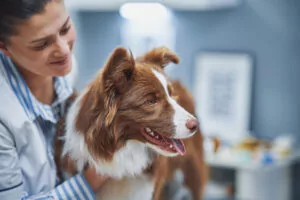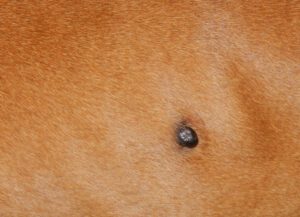My Dog Has a Lumpy Mass Growth. Is it Cancer?
Finding an unusual lump or bump on your dog can send you into a tailspin. Many dog parents automatically assume the worst and may worry their pup has a cancerous tumor. Nevertheless, lumps or a growth on your dog can often be benign.
If you find a lumpy growth on your dog, you should take them to the veterinarian immediately. Additionally, your pup should see a vet if you see a change in the color, size, or texture of any existing bumps on their body. If any bumps contain pus, they should also be examined.
If you want to find out why your dog has a lumpy mass growth and if it is cancer, check out this article.

Benign Lumps or Growths on Dogs
There are many kinds of lumps and bumps that can grow on dogs. Lots of them are benign, which indicates that they are non-cancerous. If you discover a lump on your pup, do not fear. However, you should always have your veterinarian look at it to be on the safe side. The following are some lumps and bumps you may find on your dog that are typically benign:
Benign Lumps
Benign lumps cannot invade other tissues or spread anywhere in the body. Most of these bumps are harmless. However, the ones that continue to grow may impede the dog’s ability to move or even breathe due to their size or location. The pup may also take to scratching profusely at the lump due to its size. If this is the issue, you should speak to your vet about eliminating them.
Lipomas
Lipomas appear like fatty lumps under the pup’s skin. They are comprised of fat cells and are always benign or non-cancerous. These growths are extremely common in dogs and may be present in older pups or overweight pooches. The characteristics of lipomas are that they’re:
- Hemispherical
- Hairy
- Small
- Soft
Lipomas are often found in the abdomen, legs, or chest area. They start small but can grow to be painful and debilitating. If they begin to hinder movement or have grown too large, your vet may need to remove them.
Abscesses
These lumps are swollen and contain pus. They are usually caused by infection and can result from a bug bite or other sores. Abscesses may be buried under the pup’s fur and can be challenging to spot. Abscesses may be:
- Painful
- Warm
- Soft
- Firm
Abscesses can also develop a foul odor. The dog may increasingly lick the area where the abscess is located. Abscesses should be lanced, drained, and cleaned for proper healing. Your veterinarian will need to perform this procedure and administer anesthesia to your dog.
Sebaceous Cysts
These cysts are benign and minor and resemble a pimple or a wart. They may appear white or slightly blue. The sebaceous gland becomes blocked and filled with white pus, often swells, and becomes exceptionally sore. They can also be hard or squishy and are slow-growing. These cysts typically develop on the pup’s head, neck, torso, or upper legs.
Skin Tags 
Skin tags are non-cancerous bumps that look like a raised bump on the skin, or they could appear to be hanging from a stalk. They are caused by overactive cells, and some have hair growing on them. Skin tags are often found on the dog in the area of the:
- Stomach
- Armpits
- Eyelids
- Chest
- Face
- Nose
Many skin tags do not grow, but some grow or change in shape or size over time. They range from about a few millimeters to two centimeters or larger. Many pet parents often believe the skin tag is a tick and try to remove it with tweezers. However, skin tags are generally the color of the pup’s skin, and ticks are usually dark brown.
Sebaceous Adenomas
Sebaceous adenomas are non-cancerous growths on the dog’s sebaceous glands, which produce oil for the skin. Some secrete oil, making the pup’s fur slick and oily. They are small and usually pinkish-white in color. They may also appear to look like cauliflower.
These bumps are sometimes seen in older dogs. Sebaceous adenomas can become sebaceous adenocarcinoma, which is a malignant tumor. Be vigilant and monitor any changes in the bump you may see, and get your canine companion a vet check-up to be on the safe side.
Histiocytoma
These tumors are often referred to as “button tumors.” They typically occur in dogs that are under the age of three. These tumors are typically fast-growing; they are usually benign and frequently go away on their own. They are:
- Less than an inch in size
- Non-painful
- Hairless
- Raised
- Firm
- Red
The overproduction of immune cells causes these tumors. Histiocytomas can look very similar to serious tumors. Anytime you see any questionable growth on your canine, you should get them to the vet immediately.
Malignant Bumps, Lumps, and Tumors on Dogs
Although many bumps, lumps, and growths are non-cancerous, it is still important to get them checked out by a veterinarian as soon as possible to rule out the possibility of cancer. If they do come back as cancerous, your vet will recommend a treatment plan that fits you and your pup best. Some examples of malignant bumos, lumps, and growths include:
Malignant Lumps
Malignant lumps are cancerous and can develop and expand throughout the canine’s body. They destroy nearby tissues, or the tumor cells can come through the bloodstream or lymphatic system and spread to other places. They can affect vital areas of the body, including the:
- Liver
- Lungs
- Brain
- Bones
You need to surgically remove these tumors on your pup before they spread to other areas of the body. Your vet may recommend chemotherapy and radiation therapy to prevent cancer from spreading.
Mast Cell Tumors
The most widespread skin tumor for dogs is the mast cell tumor. Often seen in older pups, they develop from cells of the immune system called mast cells. These tumours are often beneath or on top of the skin, and they may be soft and irregular in shape. If you find this type of tumor in your canine, you should get them to the vet immediately.
Melanomas
Melanomas are tumors primarily seen in the dog’s oral cavity. Older pups and smaller breeds tend to be more susceptible to it. They are usually solitary tumors. However, they can also spread to the soft tissue or bone. Many melanomas may be dark in color. However, some tumors can be pink or another color. Melanomas can be benign or malignant.
Mammary Carcinoma
Breast cancer is often seen in female pups who have not been fixed or were fixed after two years of age. Spaying before the first or second heat phase substantially lowers the pup’s risk of developing mammary gland tumors.
However, they can occur in male dogs. These tumors are sometimes benign in females but are almost always malignant in males. The pup may have severe swelling, redness, and pain in the gland with the tumor.
Conclusion
Not every lump or bump on your dog is a cause for concern. However, anytime you see a mysterious bump on your canine companion, you should take them to the vet to make sure it is not harmful or cancerous.
For pet parents in the Mishawaka, IN region, Lincolnway Veterinary Clinic is here and offers an in-house vet lab to help you and your pet. Give us a call at (574) 256-1871 or book an appointment today!

